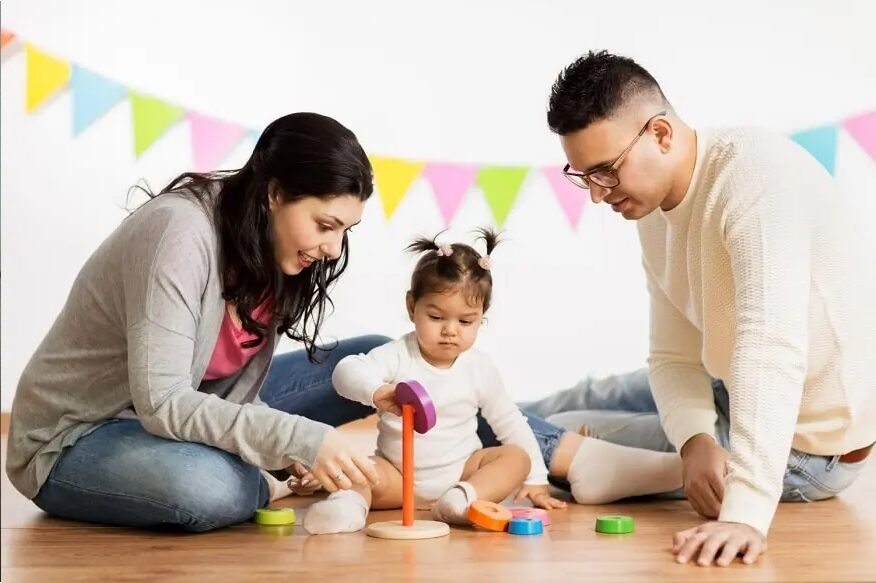For parents and caregivers, the toddler years—a time full of fast development and growing independence—often seem like a rollercoaster. Those lovely small people who are beginning to negotiate the world, communicate their wants, and challenge limits can also set off episodes of stress and irritation. Tantrums break out for apparently little problems, expectations grow, and communicating feels like learning a secret code. Natural human reaction in these times might be to yell, feel your patience running thin, or act in a way you later come to regret. Learning how to remain cool and talk gently throughout these toddler struggles is not only helpful, though; it’s also very vital for building a safe bond, encouraging good emotional development, and establishing a more serene household. This blog article will explore doable techniques and wise advice on how to keep cool when your child tests you and interact with them in a way that supports their development and deepens your relationship.

Understanding the “Why”: Decoding Toddler Behavior
First of all, you must know the developmental level your child is at if you are to remain cool and talk gently among obstacles of a toddler. Usually between the ages of one and three, toddlers are going through a rainbow of new emotions, learning to speak, and are increasing in self-awareness. Particularly the prefrontal cortex in charge of impulse control and logical thinking, their brains are still under building. Many times, this neurological immaturity helps to explain the apparently illogical conduct that might try our tolerance.
Think over these important facets of toddler development:
- Restricted language proficiency: Although their language is growing quickly, toddlers may lack the exact words to communicate complicated feelings as worry, irritation, or wrath. Acting out in tantrums, striking, or biting as a means of expression can follow from this.
- Toddlers are only starting to develop emotional regulation—that is, the ability to recognize, comprehend, control their emotions. Big emotions may be debilitating and they haven’t yet evolved the coping strategies to properly negotiate them.
- Yearning for Independence: This age’s characteristic is “me do it!” Toddlers are working for control and autonomy over their surroundings. Power conflicts and meltdowns might follow from their rejected efforts at autonomy.
- Egocentrism: Young toddlers may see the world just from their own point of view. Gradually developing is the ability to understand that others have diverse ideas, emotions, and needs. This can make comprehending rules difficult, sharing, or turn-taking difficult as well.
Fact: Studies on early childhood development indicate that tantrums usually strike between eighteen months and three years old. Children’s growth naturally includes learning to negotiate their emotions and establish their independence.
Case Study: Consider a two-year-old who, on a beautiful day, really wants to wear their rain boots to the grocery store. The youngster bursts into a full-fledged tantrum — sobbing, kicking, and refusing to leave the house – while their parent calmly notes that rain boots are for wet days. From the toddler’s point of view, their need to wear the boots is top priority; they lack the cognitive capacity to completely understand the parent’s reasons or control their great displeasure.
Knowing these fundamental developmental elements changes our viewpoint. Rather than seeing difficult behaviors as purposeful disobedience, we might start to perceive them as reflections of unmet needs, developmental limits, or battles with enormous emotions. The first step in keeping cool and behaving compassionately is this change of viewpoint.
Practical Strategies for Staying Calm in the Moment
Maintaining your calm might seem impossible when confronted with a screaming child or a willful rejection. Still, you may learn to keep cool under pressure by deliberate effort and practice. These are some useful tips:
- Take a long breath. Though it seems cliched, this is a useful instrument. When your annoyance starts to grow, deliberately inhale deeply and then exhale gently. This physiological response can assist to relax your nervous system and lower your heart rate. Even a few deep breaths can provide a pause that allows you to reply deliberately instead of reactively.
- Practice deep breathing techniques often, even in non-stressful circumstances. This will facilitate the availability to this approach when most needed.
- Create mental space by, if at all feasible, somewhat back off from the current circumstances. This can require momentarily mentally disconnecting or physically moving a few feet away. This little distance can be a vital buffer, keeping you from becoming caught in the toddler’s emotional intensity.
- Find Your Triggers: Look for the circumstances or actions that often set off your buttons. Knowing your triggers can help you to create plans for controlling your responses in such circumstances. If messy play often stresses you out, for instance, you might mentally prepare yourself ahead of time or create explicit limits.
- Lower Your Voice: Often raising your voice aggravates the matter and might overwhelm or scare your child. Though you might feel like yelling, deliberately strive to tone down. A quiet voice might help to defuse a situation.
- Pay attention to your feelings; accept them free from judgment. Saying to yourself, “I’m feeling frustrated right now,” will help you sort through the emotion instead of acting from it.
- Remember It’s Not Personal: Toddler behavior is seldom a personal jab directed against you. Remember that their developmental level and incapacity to completely control their emotions often determine their behavior.
- Create a Mantra: In trying circumstances, such “This too shall pass,” or “I can handle this,” pick a brief, soothing sentence to keep running through to yourself.
“The way we talk to our children becomes their inner voice.” Peggy O’dara
Using these techniques can help you start to develop your ability to remain cool under the most demanding child situations. This helps your child’s emotional management as well as your own.

The Power of Kind Communication: Speaking to Your Toddler with Respect
Once you’ve composed yourself, your toddler’s next most important need is kind communication. Their evolving sense of self, emotional stability, and capacity for learning and collaboration depend much on your words and tone. Kind communication about expressing oneself with respect, empathy, and understanding, not about caving in to every demand.
Here’s how to foster polite conversation during difficult toddler behavior:
- Speak gently: Your voice tone counts even when you establish limits or say “no.” More effective than a harsh or furious tone is a calm, firm one. Consider how you would talk to a friend who is distressed; your child would benefit much from a similar soft and caring voice.
- Get to Their Level. Lowering yourself to your toddler’s eye level physically will help them to connect and feel heard. It also lessens any intimidation they may have from your looming over them.
- Speak clearly and simply as toddlers still have growing language skills. Speak in brief, straightforward terms; steer clear of complicated ideas or convoluted explanations. Tell straight forwardly what you require or what the limitations are.
- Recognize Their Emotions: Honor their feelings even if you disagree with their actions. Declaring something like, “I see you’re feeling really frustrated because you can’t have another cookie,” makes children feel understood and validates their emotions. Though it opens the avenue for conversation, this does not imply you have to comply with their requests.
- Provide options when feasible. Giving children options inside reasonable limits helps them to develop control and lessens power conflicts. For instance, you may question “Do you want to wear the blue shirt or the green shirt?” rather than “It’s time to get dressed.”
- When dealing with difficult behavior, pay more attention to what your child did than on labeling them. Try “Hitting hurts,” instead than “You’re being bad.” We don’t strike.” This clarifies for them that their actions define the problem, not their intrinsic value.
- Model Kind Communication: Recall that your child is continuously observing and learning from you. Even in trying circumstances, polite behavior to others teaches kids important communication and respect skills.
The Impact of Communication Style
| Communication Style | Potential Impact on Toddler |
| Harsh, Yelling | Increased anxiety, fear, defiance, difficulty regulating emotions |
| Gentle, Calm | Increased sense of security, cooperation, better emotional regulation |
| Dismissive | Feelings of being unheard, invalidated, increased frustration |
| Empathetic | Feelings of being understood, increased willingness to cooperate |
Example: Instead of yelling, “Stop throwing your toys!” try getting down to their level and saying calmly, “I see you’re having fun throwing, but toys are for playing with gently. If you want to throw something, let’s throw this soft ball into the basket.”
By consciously choosing to speak kindly, even when faced with challenging behavior, you are nurturing your toddler’s emotional development, strengthening your relationship, and creating a more harmonious environment.
Proactive Strategies: Setting the Stage for Calm Interactions
Although it’s important to know how to respond gently and politely under pressure, stopping some of those events from starting in the first place would help far more in preventing their escalation. Using proactive techniques can help to greatly lower the frequency and intensity of toddler problems, therefore facilitating calmness and polite communication.
Following are some proactive strategies:
- Create regular, clear routines. Toddlers flourish on consistency. Knowing what to expect during the day helps one feel secure and less anxious, which can often set off difficult behavior. Regular routines for waking up, eating, naps, playtime, and sleep help to smooth out transitions and minimize conflict.
Fact: Studies have linked less behavioral issues in early children to regular daily routines.
- Share Age- Appropriate Expectations: Key is knowing what developmental ability your child possesses. It is unreasonable and sets everyone up for frustration expecting a two-year-old to sit still for an hour or to precisely share their toys every time. Your expectations should reflect their developmental level.
- Provide chances for independence as, as was already shown, toddlers are quite driven for autonomy. Give kids safe, age-appropriate chances to make decisions and engage in self-directed behavior include selecting their clothes, assisting with table setting, or toy storage. This can help them to lessen their need for less acceptable means of asserting control.
- Create a Developmentally Appropriate Environment: Make sure your toddler finds your house to be interesting and safe. This include designing play places, giving access to age-appropriate toys and activities, and childproofing risks. A well-suited surroundings can help to reduce irritation and boredom, which can sometimes result in difficult conduct.
- Teach your child emotional literacy—that is, help them to name and recognize their feelings. When you notice someone feeling strongly, name it for them (“You seem sad,” or “Are you feeling angry?”). This provides the groundwork for their understanding and finally control of their emotions.
- Learn positive attention. When your child is acting in desired ways, pay them lots of positive attention. Appreciate their efforts; note their collaboration; and show sincere interest in what they are accomplishing. This can lessen the need for those good actions to be sought for attention by challenging conduct and raise the possibility of their repeating.
- Plan for transitions: For toddlers, transitions between activities—that is, leaving the park, halting playtime for dinner—can be especially challenging. Before a change, warn; utilize visual signals (such as a countdown); make the change as seamless as you can. Additionally helpful occasionally is providing a little choice connected to the change.
Give a five-minute warning before leaving the playground, for instance: “In five minutes, we’ll pack up our things and go home.” Then you may ask, “Do you want to carry your bucket or your shovel?”
These proactive techniques will help your toddler live in a more predictable, supportive, and developmental appropriate environment, which will greatly lower the frequency and intensity of difficult behaviors and enable you to remain calm and speak gently when they do surface.
Seeking Support and Practicing Self-Compassion: You Are Not Alone
Navigating the toddler years is a difficult work; even with the greatest plans in place, there may be times when you find it difficult to remain cool and talk gently. Remember that you are not alone on this road and that your well-being and capacity to properly raise your child depend on your seeking of help and application of self-compassion.
Here’s why practicing self-compassion and asking for help are so important:
- Parenting presents difficult tasks: The emotional intensity, the never-ending demands, and the pure tiredness of raising small children may all wear one down. Sometimes one feels overwhelmed, annoyed, and even guilty. Self-compassion starts with an awareness of these emotions.
- You Deserve Support: Linking with other parents, relatives, or friends who know the difficulties of parenting toddlers will offer priceless emotional support and useful guidance. It may be rather validating to share your experiences and know that others find themselves in same circumstances.
- It Takes a community: True is the adage “it takes a village to raise a child”. Please don’t hesitate to ask for assistance when needed. This might entail requesting expert advice, setting playdates with other parents, or asking your spouse to cover for a little.
- Self-compassion lowers anxiety. Practicing self-compassion—that is, treating oneself with the same love and understanding you would offer a friend—can help to lessen guilt and shame when you make a mistake or respond in a way you regret. This lets you grow forward in a more upbeat manner and draw lessons from the event.
- Setting Examples for Self-Care: Being the greatest parent you can be depends on you attending to your own emotional and physical needs; it is not selfish. Giving self-care first priority helps you to meet the responsibilities of parenthood with compassion and calm. This also emphasizes for your youngster the need of self-care.
Resources and Systems of Support:
- Parenting Groups: Participating in local parenting groups or internet forums can help one feel a part of a community and have a venue to exchange knowledge and grow from others.
- Family and Friends: Count on your support system for either simply a listening ear or emotional or useful assistance.
- Therapists and Counselors: Seeking professional help might give useful tools and techniques if you find yourself regularly unable to control your emotions or feel overwhelmed.
- Parenting Books and Websites: Many tools abound that provide evidence-based guidance and help for negotiating toddlerhood.
“Self-compassion is simply giving ourselves the same kindness and care we would give to a dear friend who is struggling.” – Kristin Neff
Remember, it’s not a destination; rather, learning how to remain cool and talk gently amid toddler struggles is a lifelong journey. Days when you manage things gracefully and days when you will not. Treat yourself kindly; acknowledge your development and don’t hesitate to ask for help along the road. You’re doing an amazing job.

Conclusion: Embracing Calmness and Kindness in the Toddler Journey
Managing the toddler years is clearly a dynamic and sometimes taxing process. The path is lined with times of pure delight and connection mixed with times that try our emotional fortitude and endurance. Learning how to remain calm and talk politely throughout these toddler struggles is about learning skills and establishing a mentality that stresses connection, understanding, and polite communication rather than on attaining a condition of perpetual calmness.
Understanding the developmental basis of toddler behavior, using doable techniques for staying calm in the time, and deliberately choosing to interact with kindness can help us to create a more loving surroundings for our little children. Additionally greatly lessening the frequency of difficult circumstances are proactive steps include developing routines and encouraging independence.
Remember, ultimately, that both you and your child are learning. You will occasionally stumble; that is normal. Navigating this period with grace and resilience depends critically on developing self-compassion and looking for help from your network.
Not only are you helping your child’s emotional development by giving maintaining cool when your toddler challenges you top priority and by regularly choosing to speak sweetly a more loving and tranquil family dynamic is created. Accept the road, honor the little successes, and keep in mind that the work you put into learning how to remain cool and talk gently throughout toddler problems will pay off for your child as well as for you.






